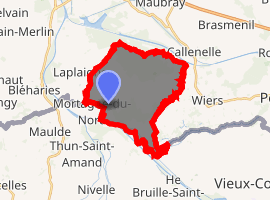Flines-lès-Mortagne
Flines-lès-Mortagne is a commune in the Nord department in northern France.
Flines-lez-Mortagne | |
|---|---|
The town hall in Flines-lès-Mortagne | |
_Nord-France.svg.png) Coat of arms | |
Location of Flines-lez-Mortagne 
| |
 Flines-lez-Mortagne  Flines-lez-Mortagne | |
| Coordinates: 50°30′28″N 3°28′02″E | |
| Country | France |
| Region | Hauts-de-France |
| Department | Nord |
| Arrondissement | Valenciennes |
| Canton | Saint-Amand-les-Eaux |
| Intercommunality | Communauté d'agglomération de la Porte du Hainaut |
| Government | |
| • Mayor (2014-2020) | Bernard Lebrun-Vandermouten |
| Area 1 | 14.45 km2 (5.58 sq mi) |
| Population (2017-01-01)[1] | 1,646 |
| • Density | 110/km2 (300/sq mi) |
| Time zone | UTC+01:00 (CET) |
| • Summer (DST) | UTC+02:00 (CEST) |
| INSEE/Postal code | 59238 /59158 |
| Elevation | 13–46 m (43–151 ft) (avg. 21 m or 69 ft) |
| 1 French Land Register data, which excludes lakes, ponds, glaciers > 1 km2 (0.386 sq mi or 247 acres) and river estuaries. | |
Heraldry
_Nord-France.svg.png) Arms of Flines-lès-Mortagne |
The arms of Flines-lès-Mortagne are blazoned : Or, a cross gules. (Bruille-Saint-Amand, Flines-lès-Mortagne, Mortagne-du-Nord and Nivelle use the same arms.) |
gollark: I *think* the issue here is in the returning bit... somehow...
gollark: Yes.
gollark: And yes, this is a hybrid of JS and SQL via template strings, isn't it great?
gollark: And this doesn't even ACTUALLY WORK.
gollark: ```javascriptexport const enqueueCrawl = async (crawlURL, tier) => { // robotsPolicy will be filled in on first actual crawl for the domain // this has to be done as a fairly complex DB-side query to prevent race conditions console.log("running insert for", crawlURL.toString()) const [domain] = await DB`INSERT INTO domains (domain, enabled, robotsPolicy, tier) SELECT ${crawlURL.hostname}, FALSE, NULL, ${tier} WHERE NOT EXISTS (SELECT id, domain, enabled, robotsPolicy, tier FROM domains WHERE domain = ${crawlURL.hostname}) RETURNING id` console.log(crawlURL.toString(), domain) // Add entry to crawl queue await DB`INSERT INTO crawl_targets (url, domain) VALUES (${crawlURL.toString()}, ${domain.id}) ON CONFLICT (url) DO UPDATE SET added = NOW()`}```This should NOT be quite so bee.
See also
References
- "Populations légales 2017". INSEE. Retrieved 6 January 2020.
| Wikimedia Commons has media related to Flines-lès-Mortagne. |
This article is issued from Wikipedia. The text is licensed under Creative Commons - Attribution - Sharealike. Additional terms may apply for the media files.